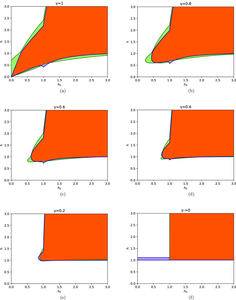淬火后非平衡态中的纠缠探测:热吉布斯与广义吉布斯集合
IF 1.6
4区 物理与天体物理
Q3 PHYSICS, CONDENSED MATTER
引用次数: 0
摘要
摘要 我们利用与状态的纠缠负性有关的纠缠见证来探测 XY 链在淬火后热力学极限状态下的纠缠,当时哈密顿参数突然改变。纠缠负性与相关性有关,在理想情况下,淬火后静止态的相关性由广义吉布斯集合描述。然而,如果存在打破可整性的扰动,系统就会热化。在这里,我们比较了这两种情况下的近邻纠缠。图解摘要XY链中突然淬火协议((h_0, \gamma ) \rightarrow (h, \gamma )\ )之后的淬火后状态。本文章由计算机程序翻译,如有差异,请以英文原文为准。

Entanglement detection in postquench nonequilibrium states: thermal Gibbs vs. generalized Gibbs ensemble
We use entanglement witnesses related to the entanglement negativity of the state to detect entanglement in the XY chain in the postquench states in the thermodynamic limit after a quench when the parameters of the Hamiltonian are changed suddenly. The entanglement negativity is related to correlations, which in the postquench stationary state are described by a generalized Gibbs ensemble, in the ideal case. If, however, integrability breaking perturbations are present, the system is expected to thermalize. Here, we compare the nearest-neighbor entanglement in the two circumstances.
Postquench states after a sudden quench protocol \((h_0, \gamma ) \rightarrow (h, \gamma )\) in the XY chain.
求助全文
通过发布文献求助,成功后即可免费获取论文全文。
去求助
来源期刊

The European Physical Journal B
物理-物理:凝聚态物理
CiteScore
2.80
自引率
6.20%
发文量
184
审稿时长
5.1 months
期刊介绍:
Solid State and Materials; Mesoscopic and Nanoscale Systems; Computational Methods; Statistical and Nonlinear Physics
 求助内容:
求助内容: 应助结果提醒方式:
应助结果提醒方式:


